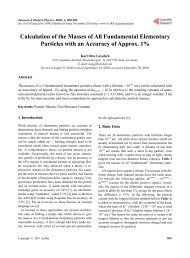Encoding multiple unnatural amino acids via evolution of a ...
Encoding multiple unnatural amino acids via evolution of a ...
Encoding multiple unnatural amino acids via evolution of a ...
Create successful ePaper yourself
Turn your PDF publications into a flip-book with our unique Google optimized e-Paper software.
LETTERS NATURE |Vol 464 | 18 March 2010<br />
Cm µg ml –1<br />
a b<br />
tRNAUCCU O-cat<br />
O – WT<br />
WT – AGGA<br />
O – AGGA<br />
16S rRNA libraries<br />
tRNA<br />
Rx<br />
Q4<br />
–<br />
–<br />
AGGA<br />
AGGA<br />
mRNA<br />
Q3<br />
Q2<br />
–<br />
–<br />
AGGA<br />
AGGA<br />
Q1 – AGGA<br />
O + AGGA<br />
Rx + AGGA<br />
Q4 + AGGA<br />
Q3 + AGGA<br />
A1197G<br />
A1196G<br />
Q2<br />
Q1<br />
+<br />
+<br />
AGGA<br />
AGGA<br />
c O-ribosome<br />
tRNAUCCU –<br />
–<br />
O<br />
–<br />
Rx Q4 Q3 Q2 Q1 O<br />
– – – – – –<br />
Rx Q4 Q3 Q2 Q1<br />
– – – – –<br />
O<br />
+<br />
Rx Q4 Q3 Q2 Q1<br />
+ + + + +<br />
16S rRNA libraries<br />
O-catWT O-catAGGA +<br />
–<br />
+<br />
–<br />
+<br />
–<br />
+<br />
–<br />
+<br />
–<br />
+<br />
–<br />
+<br />
–<br />
–<br />
+<br />
–<br />
+<br />
–<br />
+<br />
–<br />
+<br />
–<br />
+<br />
–<br />
+<br />
–<br />
+<br />
–<br />
+<br />
–<br />
+<br />
–<br />
+<br />
–<br />
+<br />
–<br />
+<br />
Figure 1 | Selection and characterization <strong>of</strong> orthogonal quadruplet<br />
decoding ribosomes. a, Mutations in quadruplet decoding ribosomes form<br />
a structural cluster close to the space potentially occupied by an extended<br />
anticodon tRNA. Selected nucleotides are shown in red. Image created using<br />
Pymol (http://www.pymol.org) and Protein Data Bank (PDB) accession<br />
2J00. b, Ribo-Qs substantially enhance the decoding <strong>of</strong> quadruplet codons.<br />
reported21–23 ). To explicitly compare the fidelity <strong>of</strong> triplet decoding<br />
and quadruplet decoding for the evolved orthogonal ribosomes and<br />
the progenitor ribosome we used two independent methods: the<br />
incorporation <strong>of</strong> 35 S-cysteine into a protein, which contains no<br />
cysteine codons in its gene9 , and variants <strong>of</strong> a dual luciferase system9,23 (Supplementary Fig. 5). We find that the triplet and quadruplet<br />
decoding translational fidelity is the same for the evolved ribosome<br />
(ribo-Q1) and unevolved and wild-type ribosomes, and the fourth<br />
base <strong>of</strong> the codon–anticodon interaction is discriminated equally<br />
well by all ribosomes (Supplementary Fig. 5).<br />
To demonstrate that the enhanced amber-decoding properties <strong>of</strong><br />
ribo-X are maintained in ribo-Q1 we compared the efficiency <strong>of</strong><br />
incorporating p-benzoyl-L-phenylalanine (Bpa) into a recombinant<br />
glutathione S-transferase–maltose binding protein (GST–MBP) fusion<br />
in response to an amber codon on an orthogonal mRNA using orthogonal<br />
ribosomes and a previously evolved Bpa-tRNA synthetase–<br />
tRNACUA pair3 (BpaRS–tRNACUA) (Fig. 2). Ribo-Q1 and ribo-X<br />
incorporate Bpa with a comparable and high efficiency in response<br />
to the amber codons in the orthogonal mRNA (compare lanes 4 and<br />
6 and lanes 10 and 12 in Fig. 2a). Ribo-X and ribo-Q1 are substantially<br />
more efficient than the wild-type ribosome at incorporating Bpa by<br />
means <strong>of</strong> amber suppression (compare lanes 4 and 6 to lane 2, and lanes<br />
10 and 12 to lane 8 in Fig. 2a).<br />
To demonstrate the utility <strong>of</strong> ribo-Q1 for incorporating <strong>unnatural</strong><br />
<strong>amino</strong> <strong>acids</strong> in response to quadruplet codons we compared the<br />
efficiency <strong>of</strong> incorporating p-azido-L-phenylalanine (AzPhe) into a<br />
recombinant GST–MBP fusion in response to a quadruplet codon<br />
using ribo-Q1 or the wild-type ribosome. To direct the incorporation<br />
<strong>of</strong> AzPhe we used the AzPheRS*–tRNAUCCU pair (a variant <strong>of</strong> the<br />
pAzPheRS-7–tRNACUA pair24 derived from the MjTyrRS–tRNACUA<br />
pair for the incorporation <strong>of</strong> AzPhe as described later). We find that<br />
ribo-Q1 substantially increases the efficiency <strong>of</strong> incorporation <strong>of</strong><br />
AzPhe in response to a quadruplet codon, and even allows the<br />
incorporation <strong>of</strong> AzPhe in response to two quadruplet codons for<br />
the first time (compare lanes 2 and 6 and lanes 4 and 8, Fig. 2b). The<br />
site and fidelity <strong>of</strong> incorporation <strong>of</strong> AzPhe were further confirmed by<br />
analysis <strong>of</strong> tandem mass spectrometry (MS/MS) fragmentation series<br />
<strong>of</strong> the relevant tryptic peptides (Supplementary Fig. 7).<br />
To take advantage <strong>of</strong> ribo-Q1 for the incorporation <strong>of</strong> <strong>multiple</strong><br />
distinct <strong>unnatural</strong> <strong>amino</strong> <strong>acids</strong> in recombinant proteins, we required<br />
442<br />
AcCm<br />
Cm<br />
0<br />
25<br />
50<br />
75<br />
100<br />
125<br />
150<br />
175<br />
200<br />
225<br />
250<br />
275<br />
300<br />
325<br />
350<br />
375<br />
400<br />
425<br />
450<br />
475<br />
500<br />
525<br />
550<br />
575<br />
600<br />
Ser 2<br />
The tRNAUCCU-dependent enhancement in decoding AGGA codons in the<br />
O-cat (AGGA 103, AGGA 146) gene was measured by survival on increasing<br />
concentrations <strong>of</strong> chloramphenicol (Cm). WT, wild type. c, Asinb, but<br />
measuring CAT enzymatic activity directly by thin-layer chromatography.<br />
AcCm, acetylated chloramphenicol; O, O-ribosome; Q1–Q4, ribo-Q1–Q4;<br />
Rx, ribo-X.<br />
mutually orthogonal <strong>amino</strong>acyl-tRNA synthetase–tRNA pairs. We<br />
demonstrated that the MbPylRS–tRNACUA pair 4,5 and MjTyrRS–<br />
tRNACUA pair 2 , each <strong>of</strong> which have previously been evolved to incorporate<br />
a range <strong>of</strong> <strong>unnatural</strong> <strong>amino</strong> <strong>acids</strong> 1,6,7,25 , are mutually orthogonal<br />
in their <strong>amino</strong>acylation specificity (Supplementary Fig. 8). We created<br />
the AzPheRS*–tRNAUCCU pair, which is derived from the MjTyrRS–<br />
tRNACUA pair, by a series <strong>of</strong> generally applicable directed <strong>evolution</strong><br />
steps (Supplementary Figs 9–11). The MbPylRS–tRNACUA pair and<br />
AzPheRS*–tRNAUCCU pair are mutually orthogonal: they decode distinct<br />
codons, use distinct <strong>amino</strong> <strong>acids</strong> and are orthogonal in their<br />
<strong>amino</strong>acylation specificity (Supplementary Fig. 12).<br />
To demonstrate the simultaneous incorporation <strong>of</strong> two useful<br />
<strong>unnatural</strong> <strong>amino</strong> <strong>acids</strong> into a single protein we combined the<br />
MbPylRS–MbtRNACUA pair, the AzPheRS* tRNAUCCU pair and<br />
a<br />
Ribosome<br />
BpaRS–tRNACUA Bpa<br />
gst(UAG) nmalE O-gst(UAG) nmalE GST–MBP<br />
b<br />
Ribosome WT<br />
Ribo-Q1<br />
AzPheRS–tRNAUCCU AzPhe<br />
+<br />
−<br />
+<br />
+<br />
+<br />
−<br />
+<br />
+<br />
+<br />
−<br />
+<br />
+<br />
+<br />
−<br />
+<br />
+<br />
gst(AGGA) nmalE 1 1 2 2 − − − −<br />
O-gst(AGGA) nmalE − − − − 1 1 2 2<br />
GST–MBP<br />
©2010<br />
Macmillan Publishers Limited. All rights reserved<br />
WT Ribo-X Ribo-Q1 WT Ribo-X Ribo-Q1<br />
+ + + + + + + + + + + +<br />
− + − + − + − + − + − +<br />
1 1 − − − − 2 2 − − − −<br />
− − 1 1 1 1 − − 2 2 2 2<br />
1 2 3 4 5 6 7 8 9 10 11 12<br />
1 2 3 4 5 6 7 8<br />
Figure 2 | Enhanced incorporation <strong>of</strong> <strong>unnatural</strong> <strong>amino</strong> <strong>acids</strong> in response to<br />
amber and quadruplet codons with ribo-Q1. a, Ribo-Q1 incorporates Bpa as<br />
efficiently as ribo-X. The entire gel is shown in Supplementary Fig. 6. b, Ribo-<br />
Q1 enhances the efficiency <strong>of</strong> AzPhe incorporation in response to the AGGA<br />
quadruplet codon using AzPheRS*–tRNAUCCU. The gel showing the ratio <strong>of</strong><br />
GST–MBP to GST as well as MS/MS spectra <strong>of</strong> the single and double AzPhe<br />
incorporations are shown in Supplementary Fig. 7. (UAG)n or (AGGA)n<br />
describes the number <strong>of</strong> amber or AGGA codons (n) between gst and malE.




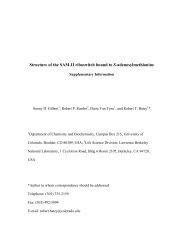
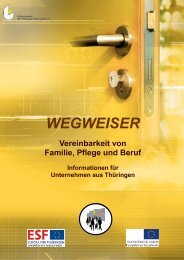
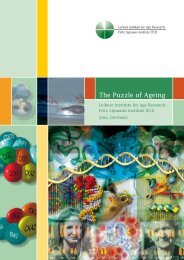

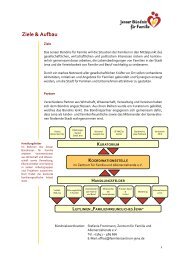



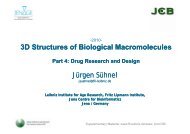
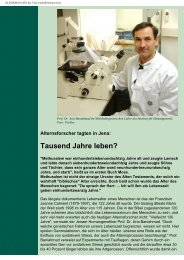

![Programm [pdf]](https://img.yumpu.com/20944039/1/184x260/programm-pdf.jpg?quality=85)
